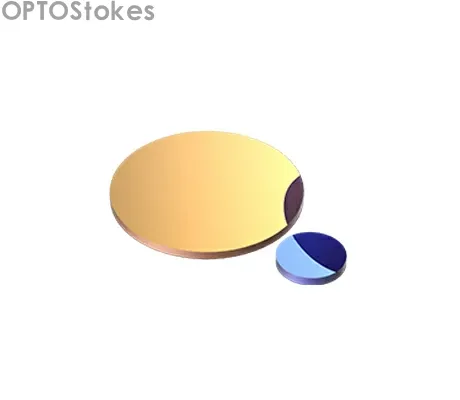
In precision optical systems, filters achieve precise control over light wavelengths. This functionality relies on two key thin-film technologies: soft coatings and hard coatings. These complementary technologies work together to shape the final performance and form of optical filters.
What Are the Differences and Characteristics Between Soft and Hard Coating Filters?
I. Soft Coating Filters: A Precise, Flexible Choice
Soft coating filters are thin films deposited via physical vapor deposition (e.g., thermal evaporation), typically without ion assistance or with low auxiliary energy. Their film structure is relatively loose, with columnar or fibrous microstructures, and a Mohs hardness generally below 5 (easily scratched by nails), resulting in lower environmental resistance.
Common materials for soft coatings include magnesium fluoride (MgF₂), silicon dioxide (SiO₂), and zinc sulfide (ZnS). MgF₂ is a classic choice for its excellent anti-reflective properties and low absorption. The deposition process involves evaporating materials in a vacuum chamber via resistance heating or electron beam bombardment, with vapor condensing on the substrate. The process temperature is relatively low.
Impact on Filter Performance
Advantages:
- Low internal stress, reducing substrate deformation risk
- Simpler process with lower costs
- Easier to achieve ultra-thick film layers
- Better compatibility with special materials (e.g., organic substrates)
Disadvantages:
- Loose, porous structure leads to low mechanical strength (easily scratched/worn)
- Poor environmental stability (absorbs moisture/contaminants, causing wavelength shifts and increased scattering)
- Lower adhesion compared to hard coatings
- Difficult to precisely control density and optical constants of high-refractive-index materials
Manufacturing standards for soft coatings focus on precise spectral performance (central wavelength, bandwidth, cutoff depth, transmittance), with lower requirements for film hardness and environmental durability (suitable for controlled environments). Controlling film thickness uniformity is a key challenge.
II. Hard Coating Filters: The Foundation of Durability
Hard coatings (Mohs hardness > 7) are deposited via high-energy processes like ion beam assisted deposition (IAD) or sputtering (magnetron sputtering, ion beam sputtering). Their structure is dense, close to bulk materials, with amorphous or fine-grained microstructures. Core materials include titanium dioxide (TiO₂), tantalum pentoxide (Ta₂O₅), hafnium dioxide (HfO₂), aluminum oxide (Al₂O₃), and silicon dioxide (SiO₂). These coatings offer water resistance, moisture resistance, high-temperature tolerance (>300°C without failure), and scratch resistance (no marks from steel wool).
Combinations of high-refractive-index materials (e.g., Ta₂O₅, TiO₂) and low-refractive-index materials (SiO₂) form the basis of high-performance interference filters.
Processing Techniques and Standards
IAD bombards the growing film with an ion beam during evaporation; sputtering uses plasma to bombard a target, ejecting atoms that deposit on the substrate. These high-energy processes result in high particle kinetic energy.
Impact on Filter Performance
Advantages:
- Extremely dense and hard film layers, with high mechanical strength (wear and wipe resistance)
- Excellent environmental stability (no moisture absorption, long-term spectral stability)
- Strong adhesion
- Stable, precisely controllable optical constants (n, k)
- Achieves steeper cutoff edges and lower scattering loss
Disadvantages:
- High internal stress (especially compressive stress), which may cause substrate bending—challenging for thin or complex-shaped substrates
- Complex processes, expensive equipment, and higher costs
- Relatively slow deposition rates
- Ultra-thick films are time-consuming to deposit, with more significant stress accumulation
Manufacturing standards are stringent: in addition to high-precision spectral performance, key indicators include film hardness (often requiring pencil hardness ≥5H), adhesion (cross-cut tape test), environmental durability (high-temperature/humidity tests, salt spray tests, wipe tests), and stress control (substrate deformation).
III. Synergistic Design: The Art of Combining Soft and Hard Coatings
Soft and hard coatings are not substitutes but work synergistically in filter structures based on performance needs and process challenges:
1. Stress Management
In hard coating multilayers, specially designed soft coating layers act as stress buffers. For example, in SiO₂/Ta₂O₅ stacks, using looser SiO₂ (close to soft coating properties) can partially offset the high compressive stress of Ta₂O₅, reducing total substrate deformation. For ultra-narrowband filters or applications requiring extreme flatness, precise stress compensation (soft-hard combinations) is critical.
2. Performance Optimization
Broadband anti-reflective (BBAR) coatings: The outermost layer often uses hard materials (e.g., SiO₂ or Al₂O₃) as a wear-resistant, anti-fouling "protective cap" to shield underlying softer layers that achieve broadband anti-reflective functionality. Internal layers may include soft coating materials for specific refractive index matching.
Special spectral requirements: Materials like ZnS or Ge exhibit unique optical properties (e.g., mid-to-far infrared characteristics) under soft coating processes, serving as functional layers in hard coating structures. Hard coating processes ensure overall structural stability and durability.
3. Process Feasibility
For ultra-thick film requirements (e.g., filters for laser damage threshold testing), pure hard coating deposition is too time-consuming with excessive stress accumulation. Instead, soft coating processes can deposit the main thick layer, with a hard protective layer added to improve surface durability. For coating complex curved substrates, hard coatings' high stress may cause cracking or delamination—making soft coatings or soft-hard combinations more feasible.
4. Cost and Efficiency
Non-critical or inner layers can use lower-cost soft coating processes when performance allows, while critical surface and protective layers require hard coatings.
IV. Practical Applications: Each Shining in Its Sphere
Soft Coating Filter Scenarios
- Laboratory and scientific instruments: Spectrometers and spectrophotometers in controlled environments, where cost sensitivity is high, and mechanical/environmental stability is less critical, but special spectral performance (e.g., specific materials, ultra-thick layers) is needed.
- Disposable or low-lifespan devices.
- Applications sensitive to substrate deformation (e.g., ultra-thin substrates, interferometer plates).
Hard Coating Filter Scenarios
- Harsh industrial environments: Machine vision inspection (automotive manufacturing) and industrial laser processing heads (resistant to dust, wipes, and coolants).
- Long-term outdoor use: Aerospace remote sensing and security cameras (resistant to temperature extremes, humidity, salt spray, and UV radiation).
- Medical diagnostic equipment: Biochemical analyzers and endoscopes (requiring strict disinfection, high reliability, and stability).
- High-end consumer electronics: Smartphone camera modules (miniaturized, scratch-resistant).
- High-power laser systems: Laser resonator mirrors and harmonic separation mirrors (requiring ultra-high laser damage thresholds, low absorption loss, and excellent thermal stability).
- Defense and military: Night vision devices and missile guidance systems (extreme environment adaptability and high reliability are critical).
V. Conclusion: Complementary Roles in Optical Systems
Soft and hard coating filters are like adagios and fortissimos in a precision optical symphony. Soft coatings, with low stress and cost advantages, enable more complex optical designs; hard coatings, with superior durability and stability, form the foundation of reliable operation in harsh environments. Their synergy—through precise stress engineering, performance, and process complementarity—is key to high-performance, reliable filters.
Advancements in ion source technology, plasma technology, optical monitoring, and materials science are blurring the lines between soft and hard coatings, with hybrid deposition and gradient layer designs emerging. Future trends will focus on leveraging their synergy to balance extreme optical performance, environmental robustness, processing efficiency, and cost—meeting demands from quantum research to deep space exploration.
At OPTOStokes, we offer a wide range of off-the-shelf optical filters with both soft and hard coatings, and can customize solutions to your specific needs. Our products meet international quality and technical standards, supported by a well-established production line ensuring controllable lead times and consistent quality. For advice or custom inquiries, please email us at sales@optofilters.com or leave a message on our website—our team is ready to assist.


